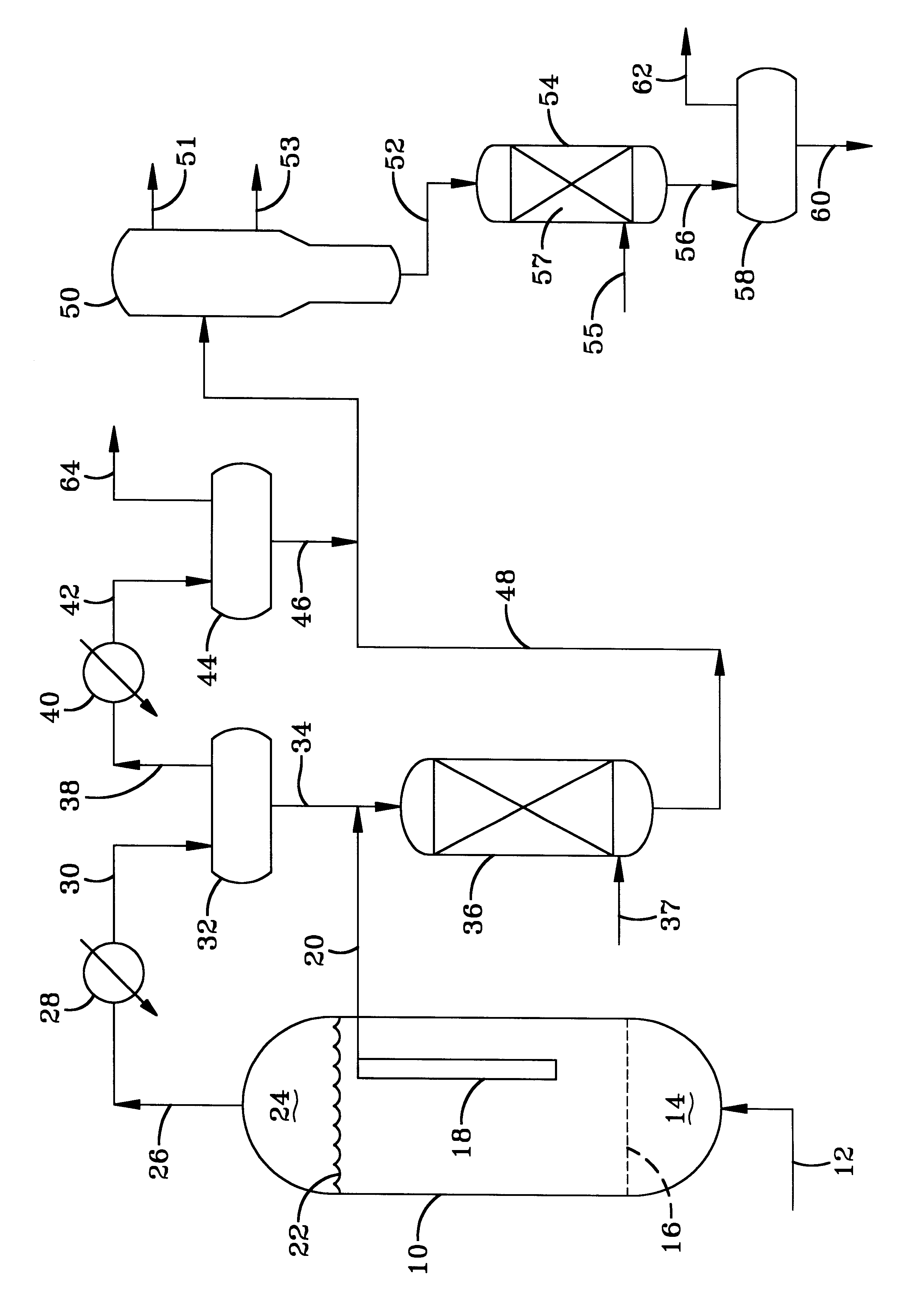Wide-cut synthetic isoparaffinic lubricating oils
a synthetic isoparaffinic and lubricating oil technology, applied in the direction of hydrocarbon oil treatment products, petroleum chemical modifications, lubricant compositions, etc., can solve the problems of oil volatility specifications, adversely affecting low temperature properties, pouring point,
- Summary
- Abstract
- Description
- Claims
- Application Information
AI Technical Summary
Problems solved by technology
Method used
Image
Examples
example 1
A mixture of H.sub.2 and CO having an H.sub.2 to CO mole ratio of 2.11-2.16 was reacted in the presence of a Fischer-Tropsch hydrocarbon synthesis catalyst in a slurry reactor to form hydrocarbons. The catalyst contained cobalt and rhenium supported on titania. The reaction was conducted at 425.degree. F. and 290 psig, at a linear feed velocity of from 12-17.5 cm / sec. The kinetic alpha of the synthesized hydrocarbons was greater than 0.9 and the hydrocarbons were flash fractionated into three fractions of C.sub.5 to about 500.degree. F., 500-700.degree. F. and a 700.degree. F.+ waxy feed. By way of further illustration, referring to the FIGURE the C.sub.5 -500.degree. F. fraction corresponds to the cold separator liquid withdrawn via line 46, The 500-700.degree. F. is the hot separator liquid withdrawn via line 34 and the 700.degree. F.+waxy feed is the hot, waxy filtrate withdrawn from the reactor via line 20.
example 2
The 700.degree. F.+ waxy feed fraction was mildly hydroisomerized by reacting with hydrogen in the presence of a fixed bed of a dual function catalyst consisting of cobalt (CoO, 3.2 wt %) and molybdenum (MOO.sub.3, 15.2 wt. %) on a silica-alumina cogel acidic support containing 15.5 wt. % silica. The catalyst had a surface area of 266 m.sup.2 / g and pore volume (P.V..sub.H2O) of 0.64 mL / g. The reaction conditions included a temperature of 713.degree. F., a hydrogen pressure of 725 psig, a hydrogen treat rate of 2500 SCF / B, an LHSV of 1.1 v / v / hr and a 700.degree. F.+ conversion target of 50 wt. %. The 700.degree. F.+ conversion is defined as:
700.degree. F.+ conversion =[1-(wt. % 700.degree. F.+fraction in product) / (wt. % 700.degree. F.+in feed).times.100
The resulting hydroisomerate was fractionated into lighter fuel fractions and a waxy 700.degree. F.+ fraction whose properties are given in Table 1 below.
example 3
In this example, the pour point of the waxy, 700.degree. F.+hydroisomerate produced in Example 2 was catalytically dewaxed by reacting with hydrogen in the presence of a dewaxing catalyst consisting of 0.5 wt. % platinum supported on H-mordenite at a temperature of 550.degree. F., hydrogen pressure of 725 psig, a hydrogen treat rate of 2500 SCF / B and LHSV of 1.1 v / v / hr. The dewaxing was conducted at a 20 volume % conversion of the 700.degree. F.+hydroisomerate feed and the resulting base stock had a boiling range of from about 750.degree. F., to greater than 1050.degree. F. and a pour point of +3.degree. F. However, low temperature performance is better indicated by lubricating oils formulated from the base stocks of the invention using other low temperature tests, such as the Cold Cranking Simulator (CCS) viscosity typically used to assess passenger car motor oils, and the Brookfield viscosity used to assess automatic transmission fluids. Table 2 shows a comparison of fully formula...
PUM
 Login to View More
Login to View More Abstract
Description
Claims
Application Information
 Login to View More
Login to View More - R&D
- Intellectual Property
- Life Sciences
- Materials
- Tech Scout
- Unparalleled Data Quality
- Higher Quality Content
- 60% Fewer Hallucinations
Browse by: Latest US Patents, China's latest patents, Technical Efficacy Thesaurus, Application Domain, Technology Topic, Popular Technical Reports.
© 2025 PatSnap. All rights reserved.Legal|Privacy policy|Modern Slavery Act Transparency Statement|Sitemap|About US| Contact US: help@patsnap.com

